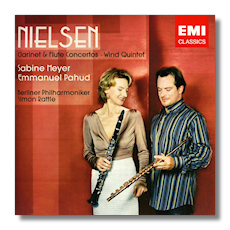
The Internet's Premier Classical Music Source
Related Links
- Nielsen Reviews
- Latest Reviews
- More Reviews
-
By Composer
-
Collections
DVD & Blu-ray
Books
Concert Reviews
Articles/Interviews
Software
Audio
Search Amazon
Recommended Links
Site News
 CD Review
CD Review
Carl Nielsen

- Clarinet Concerto
- Flute Concerto
- Wind Quintet
Sabine Meyer, clarinet
Emmanuel Pahud, flute
Stefan Schweigert, bassoon
Jonathan Kelly, oboe & cor anglais
Radek Baborák, French horn
Berlin Philharmonic Orchestra/Simon Rattle
EMI Classics 3-94421-2
Here's a logical grouping of works; you'd think that this combination would be more frequent on CD. Had Nielsen lived longer, there might have been concertos for bassoon, oboe, and french horn, as he at one time expressed the intention of composing concertos for all five members of the Copenhagen Wind Quintet – the first performers of the quintet recorded here. As it is, he completed only the Flute Concerto and the Oboe Concerto.
These works were composed during the last decade of Nielsen's life – the Fifth Symphony predates all three of them. By this time, his style had become more pared-down, and his emotional expression more ambivalent. On one level, one can hear these works simply as perceptive tributes to the musicians that inspired them – Holger Gilbert-Jespersen (flute), Aage Oxenvad (clarinet), and the other members of the Copenhagen Wind Quintet. The catastrophe of World War I also must have played a role in the evolution of Nielsen's music in the 1910s and 1920s, in particular by making Nielsen's sense of humor blacker and more grotesque than it was before.
There's no lack of finesse to these performances. All five musicians are current or former members of the Berlin Philharmonic – in the case of Sabine Meyer, during the latter part the Karajan era. (Her unhappy experience as the Philharmonic's only female musician at that time – the other members voted her out! – must give spice to her current work with this orchestra!) Back in the 1960s, when many people were discovering Nielsen's music, the concertos in particular seemed difficult and awkward, but performances like these show how much they've become part of musicians' vocabularies in just a few decades. If anything, there's a risk that this new facility will make performances sound a little glib, and perhaps that danger isn't entirely avoided here. Rattle's speedy tempos in the Clarinet Concerto is part of that; the total time here is 23:29, as opposed to the almost 27 minutes required by soloist Ib Erikson and conductor Mogens Wöldike for Decca in 1954. The Flute Concerto is more in line with traditional tempos, but even here, Rattle pushes the music hard in some sections. On the other hand, the music's brashness is thereby emphasized. As for the Wind Quintet, one could hardly ask for a more polished performance, although it is not ideally characterful.
The sound is excellent, and Stephen Johnson's booklet notes introduce the music adequately.
Copyright © 2008, Raymond Tuttle




















